
There are many options for cold and flu remedies that kids can use. You can use salt water, Nasal drops, Vitamin C and avoid smoking to relieve stuffy nose. A doctor may be needed if the symptoms do not disappear after three days. A child's lifestyle could be responsible for symptoms like the flu and smoking.
Home remedies for a stuffy nostril
If you have a child with a stuffy nose, you should consider home remedies for cold and flu for kids. Children under the age of 6 may not be able to take over-the–counter medication for cough. Drying their nasal passages can make it worse. Encourage your child to drink lots of water to maintain nasal tissue moisture. Make 100% fruit popsicles yourself or get them from the grocery shop. These are likely to be preferred over water by your child so avoid products with caffeine.
Gargling with saltwater
For hundreds of years, salt water gargling has existed. The study of 400 people showed that gargling with salt water resulted in a 40% decrease in upper respiratory tract infections. Gargling salt water with saline pulls fluid from inflamed tissue, which causes mucus to be loosen and flushes out other irritants. Gargling with salt water is recommended by the Mayo Clinic and should be done for about three seconds.

Nasal saline drops
Children who suffer from respiratory infections or the common cold may experience congestion in their noses. This can be relieved by nasal saline sprays, drops, and creams. By thinning the mucus and reducing swelling, these remedies can help children breathe easier. Because they do not contain any medications, they are recommended by pediatricians for children and infants. Continue reading to find out how to apply these drops on your child's nose.
Vitamin C
Vitamin C has been long touted as a cure for common cold symptoms, but there is not much evidence supporting its use as therapeutic treatment. While a prophylactic dose of vitamin C, as a preventive measure, might be effective in reducing cold symptoms, the benefits for children are not clear. The optimal timing and dose of vitamin C supplementation is still unknown. Prophylactic vitamin C has a much higher effect on children than therapeutic doses.
Echinacea
Echinacea is a natural remedy for the flu and cold that parents can use to help their children. This perennial flowering plant, also called coneflower, has brightly colored petals surrounding a spiky seed head, which may be red or purple. There are many species of Echinacea and their medicinal properties may vary. This herb contains a complex mixture of active compounds, including phenols, which control enzymes and cell receptors.

FAQ
What are 10 healthy habits you can adopt?
-
Have breakfast every day.
-
Don't skip meals.
-
Maintain a balanced diet.
-
Drink plenty of water
-
Take good care of your body.
-
Get enough sleep.
-
Stay away from junk foods.
-
Do some form of exercise daily.
-
Have fun
-
Make new friends
Exercise: Is it good or bad for immunity?
Exercise is good to your immune system. Exercise increases white blood cell production, which helps fight off infection. Your body also eliminates toxins. Exercise is a great way to prevent heart disease, cancer, and other diseases. Exercise also helps to reduce stress levels.
However, exercising too much can weaken your immune system. When you exercise too hard, your muscles will become sore. This causes inflammation, swelling, and can even lead to death. Your body will then produce more antibodies in order to fight infections. These extra antibodies can lead to allergies or autoimmune disorders.
So, don't overdo it!
These are 5 ways you can live a healthy and happy life.
Healthy living means eating right, exercising regularly and getting enough sleep. It also involves managing stress and having fun. Avoiding sugar and processed foods is key to eating well. Exercise burns calories and strengthens the muscles. Sleeping enough can improve memory and concentration. Managing stress reduces anxiety and depression. Fun is key to staying young and vibrant.
What's the difference between fat or sugar?
Fat is an important energy source, which comes from food. Sugar is a sweet, naturally occurring substance in fruits and vegetables. Both fats as well as sugars contain the same amount of calories. Fats however, have more calories than sugars.
Fats are stored in your body and can cause obesity. They can cause cholesterol buildup, which can lead you to heart attacks and strokes.
Sugars provide instant energy and are rapidly absorbed by the body. This causes blood glucose levels to rise. High blood glucose levels are dangerous as it can increase the likelihood of developing type 2 diabetes.
What are the 10 most delicious foods?
These are the 10 best foods to try:
-
Avocados
-
Berries
-
Broccoli
-
Cauliflower
-
Eggs
-
Fish
-
Grains
-
Nuts
-
Oats
-
Salmon
How do I get enough vitamins for my body?
Most of your daily vitamin requirements can be met by diet alone. Supplements can be helpful if you are lacking in any one vitamin. A multivitamin supplement can provide all the vitamins you require. You can also buy individual vitamins at your local pharmacy.
If you are concerned about getting enough nutrients, talk to your doctor about what foods contain the best sources of vitamins. For example, dark green leafy vegetables such as spinach, broccoli, kale, collard greens, turnip greens, mustard greens, bok choy, romaine lettuce, arugula, and Swiss chard are rich in vitamins K and E. Other good sources include oranges, tomatoes, strawberries, cantaloupe, carrots, sweet potatoes, pumpkin, and squash.
Ask your doctor to help you determine the right amount of vitamin. The doctor will determine the proper dosage based upon your medical history as well as your current health.
How does an anti-biotic work?
Antibiotics can be used to kill bacteria. Antibiotics are used for treating bacterial infections. There are many kinds of antibiotics. Some are administered topically, while others can be taken orally.
People who have been infected with certain germs may need antibiotics. An oral antibiotic might be prescribed to someone who has been exposed to chicken pox. This will prevent the spread of shingles. Or, if someone has had strep throat, he or she might receive an injection of penicillin to help prevent pneumonia.
Doctors should prescribe antibiotics to children. Children are more likely to experience side effects than adults from antibiotics.
Diarrhea, the most common side-effect of antibiotics, is probably diarrhea. Other side effects possible include dizziness, nausea, vomiting, stomach cramps, dizziness and allergic reactions. These side effects are usually gone once the treatment is complete.
Statistics
- According to the Physical Activity Guidelines for Americans, we should strive for at least 150 minutes of moderate intensity activity each week (54Trusted Source Smoking, harmful use of drugs, and alcohol abuse can all seriously negatively affect your health. (healthline.com)
- WHO recommends consuming less than 5% of total energy intake for additional health benefits. (who.int)
- According to the 2020 Dietary Guidelines for Americans, a balanced diet high in fruits and vegetables, lean protein, low-fat dairy and whole grains is needed for optimal energy. (mayoclinichealthsystem.org)
- The Dietary Guidelines for Americans recommend keeping added sugar intake below 10% of your daily calorie intake, while the World Health Organization recommends slashing added sugars to 5% or less of your daily calories for optimal health (59Trusted (healthline.com)
External Links
How To
How to live a healthy lifestyle
A healthy lifestyle is one where you are able to maintain your weight, your health and your fitness level. This lifestyle includes healthy eating habits, regular exercise, adequate sleep, and abstaining from drugs, alcohol, caffeine, tobacco and other harmful substances. A healthy lifestyle can help you feel confident and fit. In addition, a healthy lifestyle reduces your risk of chronic diseases like heart disease, stroke, diabetes, cancer, osteoporosis, arthritis and many others.
This guide will help you live a healthier, more fulfilling life. The first part of the project consisted of writing the introduction, which explains what a healthy lifestyle is, why people should adopt a healthy lifestyle and who we are. Then, I wrote the body paragraphs, which consist of different tips on how to keep a healthy lifestyle. Finally, I wrote the conclusion, which summarizes the whole article and provides some additional resources if needed.
This assignment taught me how to write a concise paragraph. I learned how my ideas could be organized into topic sentences. Additionally, I learned how to organize my ideas into topic sentences and supporting details. I also learned how to write with proper grammar.